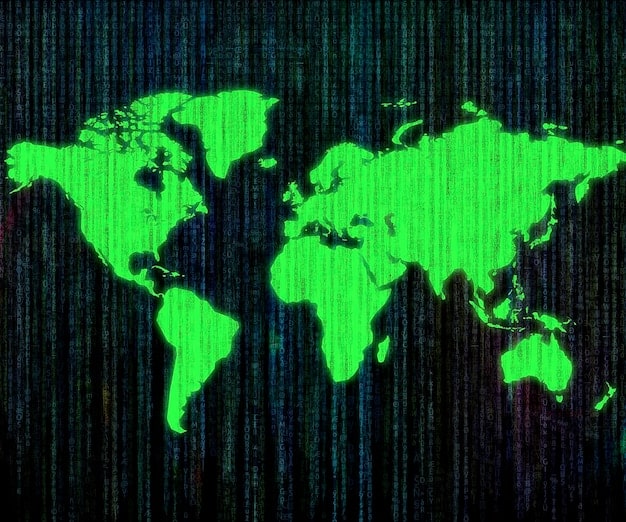Geopolitical Conflicts and Cybersecurity: Preparing for Nation-State Attacks

Geopolitical conflicts significantly amplify cybersecurity risks, leading to increased nation-state attacks and data warfare, necessitating robust preparation and defense strategies for organizations and governments.
The escalating tensions in global geopolitics are casting a long shadow over the digital realm. The impact of geopolitical conflicts on cybersecurity: preparing for nation-state attacks and data warfare is now a paramount concern for organizations, governments, and individuals alike.
Understanding the Intersection of Geopolitics and Cybersecurity
The relationship between geopolitics and cybersecurity is becoming increasingly intertwined. As nations jostle for power and influence on the world stage, the digital domain has emerged as a key battleground.
Geopolitical conflicts often spill over into cyberspace, resulting in heightened cyber activity, including espionage, sabotage, and disinformation campaigns. Understanding this connection is crucial for anticipating and mitigating potential threats.
How Geopolitical Tensions Fuel Cyber Warfare
Geopolitical tensions create an environment conducive to cyber warfare. When nations are at odds, they may use cyberattacks as a means of coercion, intelligence gathering, or disruption.
- Nation-state actors often target critical infrastructure, such as power grids, water supplies, and communication networks, to cause chaos and undermine public confidence.
- Cyber espionage is used to steal sensitive information, including government secrets, trade secrets, and intellectual property.
- Disinformation campaigns are waged to manipulate public opinion, sow discord, and undermine democratic processes.
Cyber warfare is often conducted in the shadows, making attribution difficult and escalation a constant risk. This ambiguity can lead to miscalculations and unintended consequences.
In conclusion, the intersection of geopolitics and cybersecurity creates a complex and volatile landscape. Organizations and governments must understand this connection to effectively defend against nation-state attacks and data warfare.
The Rise of Nation-State Cyberattacks
Nation-state cyberattacks are becoming increasingly sophisticated and frequent. These attacks are often well-funded, highly coordinated, and difficult to defend against. They represent a significant threat to national security, economic stability, and individual privacy.
Nation-states possess the resources and capabilities to develop advanced cyber weapons, recruit skilled hackers, and conduct long-term cyber campaigns. These campaigns can have far-reaching consequences.

Characteristics of Nation-State Cyberattacks
Nation-state cyberattacks are characterized by their sophistication, persistence, and strategic objectives. Unlike cybercriminals, who are primarily motivated by financial gain, nation-state actors often have broader political or military goals.
- Advanced persistent threats (APTs) are a common tactic used by nation-state actors. APTs involve gaining unauthorized access to a network and remaining undetected for an extended period, allowing the attacker to steal data or disrupt operations at will.
- Zero-day exploits, which are vulnerabilities in software that are unknown to the vendor, are often used to gain initial access to a target system.
- Spear-phishing attacks, which target specific individuals within an organization, are used to steal credentials or deliver malware.
Nation-state cyberattacks are constantly evolving, with new tactics and techniques emerging all the time. This requires organizations to stay vigilant and adapt their defenses accordingly.
In conclusion, the rise of nation-state cyberattacks presents a formidable challenge to cybersecurity professionals. Organizations must invest in advanced security technologies and develop robust incident response plans to protect against these threats.
Understanding Data Warfare and Its Implications
Data warfare is an emerging form of conflict that involves the manipulation, theft, or destruction of data. It can be used to achieve a variety of objectives, including espionage, sabotage, and disinformation. Data warfare poses a significant threat to individuals, organizations, and nations.
Data is increasingly becoming a valuable asset, and as such, is a prime target for attackers. The implications of data warfare are far-reaching, affecting everything from national security to economic stability.
The Tactics of Data Warfare
Data warfare encompasses a range of tactics, including:
- Data breaches, which involve the unauthorized access and exfiltration of sensitive data.
- Data manipulation, which involves altering or falsifying data to achieve a specific objective.
- Data destruction, which involves deleting or corrupting data to disrupt operations or cause damage.
Data warfare is often conducted in conjunction with other forms of cyberattack, such as malware infections and denial-of-service attacks. The goal is to undermine the integrity, availability, and confidentiality of data.
Understanding the tactics of data warfare is essential for developing effective defenses and mitigating potential damage.
In conclusion, data warfare is a growing threat that requires a comprehensive and proactive approach to cybersecurity. Organizations must implement robust data protection measures, including encryption, access controls, and data loss prevention technologies, to safeguard their valuable data assets.
Critical Infrastructure Vulnerabilities
Critical infrastructure, such as energy, transportation, and communication networks, is particularly vulnerable to cyberattacks. These systems are essential for the functioning of modern society, and any disruption can have severe consequences. The interconnectedness of critical infrastructure makes it a prime target for nation-state actors.
Many critical infrastructure systems were designed and built before cybersecurity was a major concern. This means that they often lack basic security controls and are vulnerable to known exploits.

Securing Critical Infrastructure from Cyber Threats
Securing critical infrastructure requires a multi-layered approach that includes:
- Implementing robust security controls, such as firewalls, intrusion detection systems, and multi-factor authentication.
- Conducting regular vulnerability assessments and penetration testing to identify and remediate security weaknesses.
- Developing incident response plans to quickly detect, contain, and recover from cyberattacks.
- Sharing threat intelligence with other organizations in the critical infrastructure sector.
Collaboration between government and the private sector is essential for securing critical infrastructure. Government agencies can provide guidance, funding, and threat intelligence, while private sector organizations can implement security measures and share best practices.
In conclusion, protecting critical infrastructure from cyber threats is a national security imperative. A coordinated effort is needed to improve the security posture of these systems and mitigate the risk of catastrophic cyberattacks.
Defensive Strategies and Best Practices
Defending against nation-state cyberattacks and data warfare requires a comprehensive and proactive approach. Organizations must implement a range of security measures, including technical controls, policy enforcement, and employee training.
A strong security posture starts with a clear understanding of the threat landscape and the organization’s own vulnerabilities. This requires a continuous process of risk assessment, vulnerability management, and threat intelligence gathering.
Key Defensive Strategies for Cybersecurity
Some key defensive strategies for cybersecurity include:
- Implementing a zero-trust security model, which assumes that no user or device is trusted by default and requires strict authentication and authorization for every access request.
- Using multi-factor authentication to protect against password theft and phishing attacks.
- Implementing endpoint detection and response (EDR) solutions to detect and respond to malware and other threats on individual devices.
- Using security information and event management (SIEM) systems to collect and analyze security logs from various sources and identify suspicious activity.
In addition to technical controls, organizations must also develop and enforce security policies that address issues such as data protection, access control, and incident response. Employee training is also essential for raising awareness about cyber threats and promoting secure behavior.
In conclusion, a strong defense against nation-state cyberattacks and data warfare requires a combination of technical controls, policy enforcement, and employee training. Organizations must adopt a proactive and layered approach to security to protect their assets and mitigate potential damage.
The Role of International Cooperation
International cooperation is essential for addressing the challenges of cyber warfare and data warfare. Cyber threats often originate from across borders, and no single nation can effectively defend against them alone. Collaboration is needed to share threat intelligence, coordinate incident response, and develop international norms of behavior in cyberspace.
Several international organizations, such as the United Nations, the European Union, and the North Atlantic Treaty Organization (NATO), are working to promote international cooperation on cybersecurity. These organizations provide platforms for countries to share information, develop common policies, and conduct joint exercises.
Challenges to International Cooperation in Cyberspace
Despite the importance of international cooperation, there are several challenges that hinder progress:
- Differing national interests and priorities can make it difficult to reach consensus on common policies.
- Attribution of cyberattacks is often difficult, making it challenging to hold perpetrators accountable.
- Lack of trust between nations can impede the sharing of threat intelligence.
Overcoming these challenges requires a commitment to transparency, diplomacy, and mutual respect. Nations must be willing to share information and work together to address common threats.
In conclusion, international cooperation is essential for building a more secure and stable cyberspace. By working together, nations can deter cyberattacks, hold perpetrators accountable, and promote responsible behavior in the digital domain.
| Key Point | Brief Description |
|---|---|
| 🌍 Geopolitics & Cyber | Conflicts amplify cyber risks, leading to nation-state attacks. |
| 🛡️ Nation-State Attacks | Sophisticated, well-funded attacks targeting critical infrastructure. |
| 💽 Data Warfare | Manipulation, theft, or destruction of data for strategic advantage. |
| 🤝 International Cooperation | Essential for sharing threat intelligence and coordinating responses. |
Frequently Asked Questions (FAQ)
▼
A nation-state cyberattack is a cyberattack carried out by or with the backing of a nation-state. These attacks are often well-funded, highly coordinated, and strategically motivated.
▼
Geopolitical tensions often spill over into cyberspace, leading to increased cyber activity, including espionage, sabotage, and disinformation campaigns targeting rivalnations and critical infrastucture.
▼
Data warfare involves the manipulation, theft, or destruction of data to achieve strategic objectives, such as espionage, sabotage, or disinformation, and to compromise or gain competitive advantage.
▼
Defensive strategies include implementing a zero-trust security model, using multi-factor authentication, endpoint detection and response (EDR), and security information and event management (SIEM) systems.
▼
International cooperation is crucial for sharing threat intelligence, coordinating incident response, and developing international norms of behavior in cyberspace to create a safer digital environment.
Conclusion
In conclusion, the intensifying impact of geopolitical conflicts on cybersecurity demands a strategic and proactive approach. As nation-state attacks and data warfare become more sophisticated, organizations and governments must prioritize robust security measures, foster international cooperation, and stay vigilant to protect critical digital assets and infrastructure.





